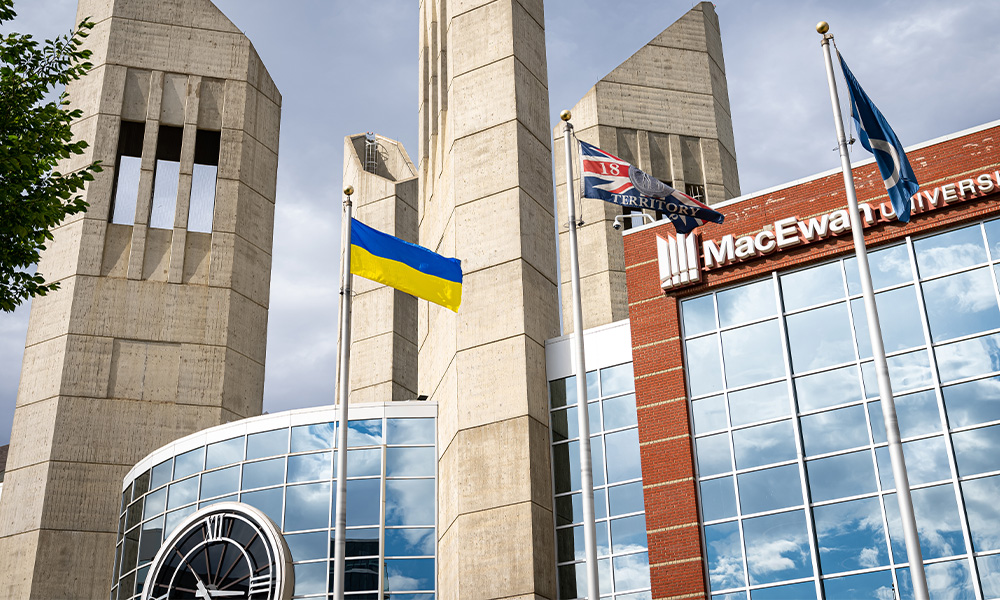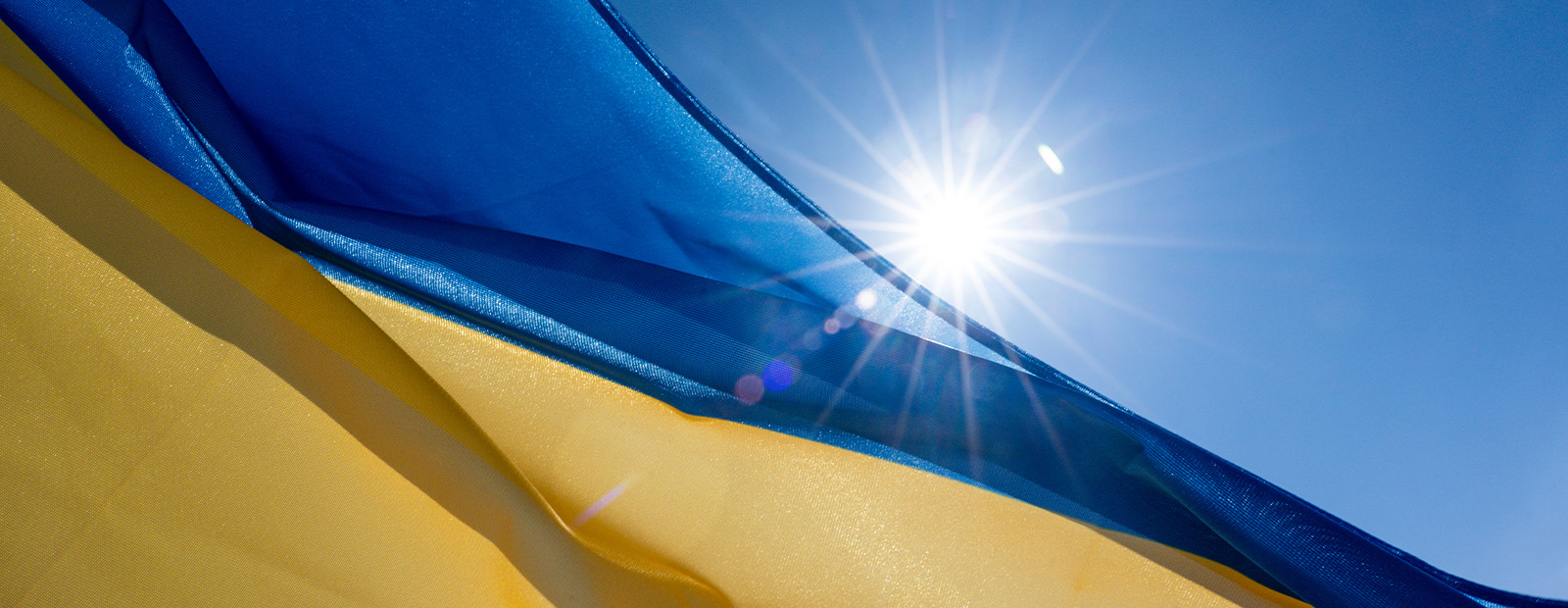Just south of Jasper Avenue, off of 105 Street, a chestnut tree grows in the middle of a parking lot. The Holowach Tree was originally planted nearly 100 years ago by Ukrainian entrepreneur Sam Holowach in the land between his family’s home and their dry cleaning business. Today, it is a physical reminder of the Ukrainian roots that many Edmontonians share.
The first wave of Ukrainians who came to Canada in the late 1800s did so primarily because of economic opportunity. Though there may not be many physical indicators of those early immigrants, Edmonton’s relationship with Ukraine and the country’s culture runs as deep as the roots of the Holowach Tree.
Today’s extensive Ukrainian community in Edmonton – growing larger now due to the war bringing the fifth wave of immigration – can largely be referred to as a diaspora, but as Dr. Jeffrey Stepnisky notes, the term isn’t simple.
“If you go back to the origins of the term diaspora, it refers to a group of people who have been forced – oftentimes for political reasons – to leave their homeland, and there is a desire to return home. So there is a sense of loss associated with diasporic communities,” says the associate professor of sociology and Kule Chair at the Ukrainian Resource and Development Centre (URDC). But nowadays, he adds, even sociologists often use it more broadly to refer to any kind of immigrant community that has some kind of connection to the homeland.
Those connections are being explored in a number of projects on and around campus. MacEwan faculty, students, staff and alumni are showcasing Ukrainian art, culture and history, as well as some of the contributions that Ukrainians have made to Edmonton since that first wave of immigration.
Using tech to preserve collective memory
In order to preserve that connection to the history of Ukrainians in Edmonton, Dr. Stepnisky has begun working with sociology chair and associate professor Dr. Michael Gulayets on The Downtown Edmonton Ukrainian Collective Memory Project. The project will eventually result in an app designed to be used in situ. Users will be able to read the history of a specific location in Edmonton while standing in that same space, which might be somewhere as unassuming as a chestnut tree in a parking lot.
“When you are physically in the spot, you get a different feel for it,” says Dr. Gulayets. “I think what the app will convey is these overlaps of layers. There’s the original Indigenous layer, and then there’s the Ukrainian layer and then the more dominant British and Scottish layer.” Some of the areas they plan to include in the app have even further cultural layers, as they’re located in neighbourhoods like Chinatown and Little Italy.
Though Holowach planted the tree as a memorial, it holds a special place in the hearts of many current Edmontonians who may not know its Ukrainian history. “I was there checking it out on Earth Day, and like 30 people on bikes showed up with environmental signs,” says Dr. Stepnisky. “It’s a special tree for the environmental community.”
The pair have been working with others around Edmonton, including Dr. Olenka Bilash at the University of Alberta, to design the app and decide what it might offer in terms of language learning tools and cultural education. Under Dr. Bilash’s leadership, they’ve also enlisted the help of three research assistants in Ukraine, who are building the app itself.
“They’re the real tech wizards. One thing that maybe people need to learn about Ukraine is that one of its most powerful sectors is information technology,” says Dr. Stepnisky. The app is still in the early stages, but the sociology profs say they may consider expanding into other cities in the future.
Podcast asks listeners to Imagine Ukraine
Preserving Ukrainian identity and history is also the focus of a project led by Dr. Lucille Mazo. The communications studies professor is working with two Ukrainian students, Sabina Mamedova and Maksym Kohutiak, to produce the Imagine Ukraine podcast. There are plans for the podcast to cover a variety of topics, from historical facts to a more contemporary look at the country’s major cities and tech developments.
“We wanted to show students across Canada that Ukraine is not just a post-Soviet country. We have an urban culture with startups and fashion, and we’re really proud of that,” says Mamedova.
The podcast will officially launch as a part of Ukraїna: From Adversity to Inspiration at MacEwan with an event on February 1. An accompanying website will launch on the same date, and include photos and information about specific locations in Ukraine. The students have high hopes for what the podcast might provide to listeners.
“I think the goal is to make a connection with Ukraine by knowing not just historical facts, but how Ukraine is modern and trendy. Through sympathy, compassion and empathy, we can transform verbal support into action,” says Kohutiak.
Visual artists fight for their work in wartime
Kohutiak’s passion for sharing Ukrainian culture isn’t limited to the podcast. He reached out to Larisa Hayduk, director of URDC, with the idea of featuring an exhibition with Ukrainian artists and filmmakers. Hayduk contacted Carolyn Jervis, director and curator of the Mitchell Art Gallery (MAG), and together they brought Give Me Tomorrow to digital screens in the atrium of Allard Hall, from October 14, 2022 through January 14, 2023.
“The six videos by eight contemporary filmmakers from Ukraine – most who are in Ukraine, but some had to flee – show how the artists transform trauma into creativity, with courage and open minds,” says Hayduk.
Jervis reached out to curator Maryna Shcherbenko, who originally created Give Me Tomorrow following Russia’s annexation of Crimea in 2014 and updated the project during the 2022 invasion of Ukraine. She agreed to showcase the exhibition at MacEwan.
“The concept of the exhibition is artists demanding a future for themselves and for their country and for their culture. Maryna writes a lot in her exhibition description about artists trying to figure out what their place is in a time of conflict, and why it’s important for artists to make work in wartime,” says Jervis.
Shumka provides community through dance
Shumka, a Ukrainian dance company located just north of MacEwan’s campus, also emerged following a time of war. “It was established in Edmonton by a group of youth, many of whom were displaced persons after the Second World War,” says MacEwan Distinguished Alumni recipient Darka Tarnawsky, Arts Administration Certificate ʼ89, who is Shumka’s executive director.
Some of Shumka’s artistic leaders studied in Ukraine during the ’70s and ’80s, and Tarnawsky herself performed in four Ukrainian cities in 1990. “The people in Ukraine didn’t expect what they saw when they came to a Shumka show. They were so impressed with how we had maintained the culture – and in fact, developed it,” she says. “We created artistic relationships on that initial tour that are still intact today.”
Now in its 63rd year, Tarnawsky feels that Shumka is a part of the cultural fabric of Edmonton. The company has been an ambassador of the city across Canada and internationally, and has participants who come from diverse cultures and backgrounds. “I think we’re a source of community that’s gone beyond the Ukrainian roots that we started with,” she says.
Celebrating the Local Narratives of notable Ukrainians in Edmonton
Showcasing the Ukrainian community in Edmonton is also the focus of Local Narratives: The Lives, Legacies, and Locales of Edmonton’s Ukrainian Canadian Community. In the fall of 2021, Hayduk began working with filmmaker Brandy Yanchuk and researcher Kalyna Somchynsky to create documentaries on notable Ukrainian figures in the city.
The project is currently paused, but Hayduk says it is critical to find time to continue. “That memory will be lost if it is not documented,” she says.
Those memories are at risk now more than ever, she says, and preserving these stories is important for more than just understanding Edmonton’s history and its relationship with Ukraine.
“The relationships that we form – in our families and work, and between Edmonton, Alberta and Ukraine – are critical for our survival, especially now,” says Hayduk. “When we come together, we create the stories that will live with us for many, many years, even after all of this is done.”
 Full story
Full story
